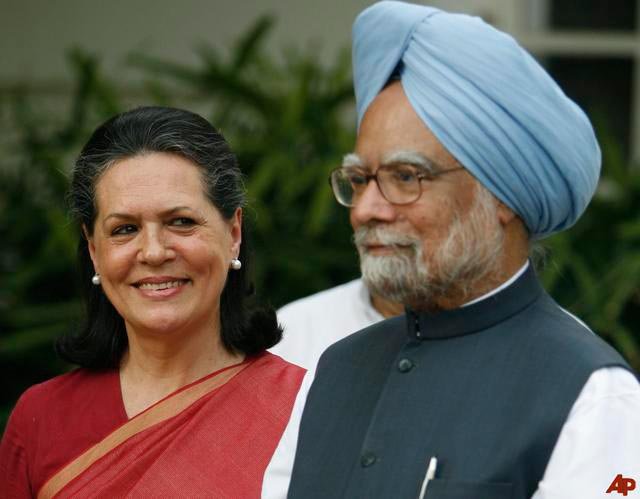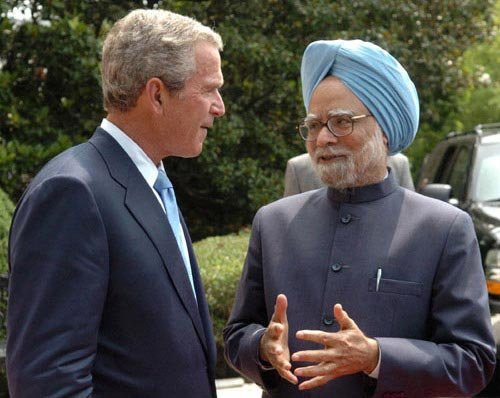Manmohan Singh : An eminent economist who had served on several highly important posts in economic field including World Bank was last made finance minister of India by Narsimha Rao in his cabinet. That was perhaps the only good thing done to the country by Mr. Rao. As finance minister Dr. Singh started the historic liberalisation process that released the trade and industry from the shackles of licences, permits, quotas and restrictions. That resulted in phenomenal economic growth of India which surprised everyone. Very soon the world saw India emerging as a new economic giant that all will have to reckon with. In its wake high salary job opportunities got created and the young India found itself on the gravy train. Millions of young Indians found plum jobs in the IT, manufacture and construction sectors, thanks to Manmohan Singh. With that formidable reputation Dr. Singh assumed office of premiership of India. Sonia Gandhi trusted him to carry on the miracle work and the countrymen trusted her judgement. Dr. Singh was (still is) a gentleman, very polite and civil as a fine educated man should be.
But for BJP leaders civilised behaviour was the sign of weakness and politeness virtue of beggars. They began abusing the civilised person taking him to be a prop of Sonia Gandhi. Some narrow minds called him Shikhandi, the eunuch of Mahabharata legend who provided cover to Arjuna to enable him to fatally wound Kaurava grandman ‘Bhishma’. The leader of opposition L.K. Advani spoke uncharitable words for Dr. Singh and never stopped mockingly terming him as ‘Weak Prime Minister’. Narendra Modi said Manmohan was puppet who would not dare drink a glass of water without seeking permission of Sonia Gandhi. The warped up minds could never digest the defeat handed out to them by Sonia Gandhi. They, especially L.K. Advani thought Dr. Singh had usurped the prime minister’s post as a proxy of Sonia Gandhi, the post that rightfully belonged to him.

The reality was that Sonia Gandhi and Dr. Singh had very civilised equation based on mutual respect. True facts they admitted without mincing words. While accepting the responsibility of prime ministership Manmohan Singh said, “I will always be thankful to Soniaji without who I could never have even imagined to become Prime Minister. I will always keep seeking her guidance.”
In the same way Sonia Gandhi respected the academic qualifications of Dr. Singh and his achievements as an economist. She earnestly wanted Dr. Singh to apply himself to his task to take the country to new heights of the economic and social transformations. That was the way Sonia Gandhi and UPA could redeem promises made to the people. It would be the common man who would be ultimate beneficiary if Manmohan Singh succeeded in his endeavours as PM. For that Dr. Singh must be allowed to function without any interference, Sonia Gandhi understood well. There also was the fact that Sonia was too civilised to indulge in uncivil act like interfering in the work of Prime Minister. She interceded only when she got too worried for the aam aadmi when prices of commodities rose alarmingly. Petty politics or ego play had no place at the top level where Sonia Gandhi and Dr. Singh functioned or dealt with each other.
How independently Manmohan Singh functioned was proven when he pused for Indo-US Nuclear Deal. In the beginning no one except Dr. Singh understood the importance of nuclear energy for India’s progress and its future power needs. Even Sonia Gandhi was not sure about it. The realisation only began to sink when Manmohan Singh explained the importance of nuclear deal for India. Then, Sonia Gandhi and UPA decided to back Manmohan Singh on the Nuclear deal and scored a historic victory.
Sonia-Manmohan’s gift to the country Indo-US nuclear deal
Manmohan Singh assessed that to sustain the economic growth of India at the current healthy rate, country would need a mind boggling amount of power, four times the present production or creation of additional 5,00,000 MW production capacity. It was only possible through nuclear power generation with its quantum jump feature. Superior nuclear technology would also be required to be imported as India was saddled with obsolete technology.
There was no other way. Most of the hydel power prospects had been covered. New rivers or valleys could not be created. Wind energy and solar energy production technologies were at fledgling stage and offered only limited scope.
Coal based power generation was counter productive, China had done it and seen its skies and rivers turn black with pollution. Climate change was another drawback of it. For India it could be suicidal because its small scale farmers could not cope with fast changing climate.
So, nuclear power provided only answer to India’s energy needs. It was pollution free and had quantum jump potential in production aspect.
But there was a big problem. India was facing nuclear isolation because of its 1974 nuclear device test and 1998 Pokharan Tests. Nuclear fuel supplies from other countries had choked off and its reactors were shutting down. Only a nuclear deal with US could end this isolation.
Manmohan Singh decided to do the deal and end India’s nuclear isolation to protect its economic progress and future. The deal would eventually translate into power for trade, industry, homes, agriculture and other sectors which would touch every Indian in some way or the other. Employment opportunities could multiply. Such a deal could give India de-facto recognition of a nuclear power and push India into ‘Trillion Dollar Economy’ club. On the International stage and forums India would hold a significant position and clout.

In 2005 Manmohan Singh visited USA as a state guest. He was accorded a grand reception at White House by President George Bush. Manmohan and Bush forged a kind of close personal equation.
Manmohan talked about the nuclear deal and George Bush readily agreed to work out the deal that would end India’s nuclear isolation. George Bush saw in it US interest also. The deal could soften the attitude of India regarding NPT and CTBT which it had been refusing to sign. Americans felt that as a de-facto nuclear power India would see its own interest in signing them instead of languish in the condemned nuclear hole alongside Pakistan. Then, there were US business interest also. A growing economy like India held a tantalising prospect for American nuclear industry for technology and fuel exports. India would be setting up a number of medium and large nuclear power generation reactors with foreign cooperation. It could lead to cooperation in other fields and US trade and industry would reap the harvest.
The deal looked immensely profitable to both the countries. At last the deal appeared to take shape as Indo-US civilian Nuclear Deal was finalised by Bush-Manmohan Singh in July, 2005. Later Bush was to visit India to take the deal further.
It was not easy to take the deal to the logical conclusion. Many hurdles had to be passed and battles had to be fought. US Congress was the first hurdle the deal had to pass. Congress was tough with its own NPT laws and would not allow any concessions. A lobby was working hard against the deal. To appease opponents some of the concessions to India had to be reworked and rediscussed. George Bush had committed himself to the deal and his capable Secretary of State, Condoliza Rice was pushing hard. Bush came to India with a delegation of US business men to a very warm welcome by Manmohan Singh and company.
Bush promised Dr. Singh that the deal will be done even at the cost of circumventing some US laws. The promise was kept and the deal passed through the US Congress in 2007.
Meanwhile, opposition parties in India were raising hue and cry against the deal on flimsy grounds. The Left parties who were supporting the UPA government ranted and threatened to withdraw the support. They were getting overtaken by their psychopathic dislike of George Bush and any deal with USA, the enemy of communism. The Left leaders wanted to kill the deal alleging that US was putting up India against China. They claimed the deal hurt the interests of India. It appeared the interest of India was not their concern. BJP was opposing the deal because habitually it opposed anything that Congress did irrespective of the merit of it. The main objective of the BJP leaders was to embarrass Manmohan Singh in any way possible. They claimed the deal was an instrument to enslave India to USA. It was bizarre charge coming out of warped up minds.
Regardless of the threats Manmohan Singh went along with the deal ready to face any situation it brought. Once the benefits of the deal to India became clear Sonia Gandhi decided to stand by her chosen man. While Dr. Singh pushed the deal Sonia Gandhi began to marshal her political forces to fight the battle for the nuclear deal.
The deal next went to Nuclear Suppliers Group for approval in 2008 based at the offices of International Atomic Energy Agency. There at the behest of Pakistan some anti-deal noises were made by China. Some other countries also expressed concerns about the concessions being made to India. Upon India’s insistence US had kept some 8 Indian nuclear reactor facilities out of the scope of international inspections in the deal to take care of India’s need for nuclear arms production for its defence. George Bush recognised the fact that India was facing two nuclear weapon states as neighbours who were not very friendly. That concession irked some countries like Japan and Australia. Dr. Singh talked to his friend George Bush and the latter obliged by mounting pressure on the countries who were holding up the Indo-US deal.
Finally it worked and the deal got the approval to the relief of India. Now the deal was becoming a reality. The Left leaders saw red and withdrew support to Manmohan Singh government reducing it to minority. Now the battle was to be fought on the floor of the parliament for the Indo-US deal. Manmohan Singh bravely took up the challenge and announced in July, 2008 the deal would be debated in the parliament and voting gone through on 22nd July. For the Indo-US Nuclear Deal, Dr. Singh had put his government and prime ministership at stake, true to his belief and commitment.
The die was cast. The managers of Sonia Gandhi at once fanned out to garner support for the government of Manmohan Singh and save the deal, so important for India’s future.
Meanwhlie, the opposition leader in parliament L.K. Advani saw in it a golden opportunity to bring down Manmohan Singh government. He dreamt of becoming Prime Minister in its wake or after early elections. He was so impatient to grab power that nothing else mattered to him.
Equally busy were Left leaders cobbling support to defeat the Indo-US deal at all costs. C.P.I. leader A.B. Bardhan ran to Mayawati, the UP Chief Minister of BSP (Bahujan Samaj Party) and promised her prime ministership if she helped them defeat the Nuclear Deal and bring down Manmohan Singh government. It was too tempting an offer for a power hungry politician to turn down. Many other outfits also supported her. Anything was possible in politics. BJP might support her just to see Manmohan Singh out. So, Mayawati announced her party would vote against the deal. But this move backfired on the opponents of the deal. Her arch rival duo of Samajwadi Party, Mulayam-Amar Singh would never vote alongside her. Just in the opposite direction they could go. Suddenly Amar Singh declared Samajwadi Party would vote for the Nuclear Deal. Sonia Gandhi, Manmohan Singh and UPA leaders now could breathe easy. Samajwadi Party had a strength of 40 MPs. It almost made up for the loss of left votes.
Then desperate opposition groups floated all kinds of canards and rumours to create misunderstandings, confusions and bad feelings. On the appointed date the debate in parliament over Indo-US Nuclear Deal began. For two days the leaders in turns spoke in favour of the deal and against while the fate of Manmohan government and the deal hung in balance. No one exactly knew which side had how many votes. It appeared 50/50 which could go either way.
During the debate three BJP members brandished bundles of currency notes reported to be the value of one crore claiming someone (Amar Singh) tried to buy them to abstain or vote in favour of the deal. It shocked everyone. Many people claimed it was an act put on by BJP leaders to discredit the outcome of the debate.
Anyway, the debate ended in the evening of July 22, 2008. The voting by push of buttons followed. The Speaker Somnath Chaterjee announced the result—’275 in favour and 256 against.’ A loud cheer rose from the treasury benches accompanied by thumping of the desks.
Sonia Gandhi and Manmohan Singh had won the battle. India would have the nuclear power and future energy security.
L.K. Advani sat crest fallen. The Left leaders had sullen faces. The game was over. But for the Nuclear Deal game was yet not over. It had to cross last hurdle. To become a final deal and US Law it must get passed by US Senate and then finally signed by the president.
In September Dr. Singh was scheduled to visit US and Washington. The programme was that George Bush and Dr. Singh were to finally seal the deal by putting their signatures in due ceremony as both had worked so hard and long for it. It had a historic importance in Indo-American relations. George Bush would have loved to put his signature on this document because it was one of his few noble deeds as the President of USA.
But that was not to be. USA had suddenly been hit by recession. The banks were failing. The US Congress was taken up with recession matters and had little time for the Indo-US deal. Dr. Singh understood predicament of US and the outgoing president George Bush. Anyway the two managed to meet and say words of thanks and sympathy to each other.
Meanwhile, US Congress had changed and now Democrats were in majority. Some of them were against the deal. But India sympathisers were in majority and finally the deal was passed.
New President of USA Barak Obama signed it.
Sonia Gandhi and her chosen man Manmohan had won a battle for India and liberated the country from the darkness of nuclear isolation jail.
Even before the final approval of US Senate, France, Russia and Germany rushed in to do deals with India and the nuclear fuel supplies had already begun to arrive to brighten up our future.
For their nefarious role in respect of the Indo-US Nuclear Deal the people properly punished the culprits in the 2009 Lok Sabha elections. The Left parties were cut to size and almost marginalised. L.K. Advani was snubbed and told indirectly people of India did not want a person of undignified impatience and foul mouth to be their prime minister.
The person whom L.K. Advani termed as ‘The weakest Prime Minister ever’ gave him the strongest rap he would ever get and never forget. The people of India could not accept the verbal abuse BJP leaders under Advani were treating the gentle and suave Manmohan Singh with. It looked so obscene and unjust. The voters revealed their mind by giving massive support to Sonia Gandhi and her trusted Manmohan Singh.
